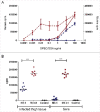Enhanced nasopharyngeal infection and shedding associated with an epidemic lineage of emm3 group A Streptococcus
- PMID: 28459299
- PMCID: PMC5711448
- DOI: 10.1080/21505594.2017.1325070
Enhanced nasopharyngeal infection and shedding associated with an epidemic lineage of emm3 group A Streptococcus
Abstract
Background: A group A Streptococcus (GAS) lineage of genotype emm3, sequence type 15 (ST15) was associated with a 6 month upsurge in invasive GAS disease in the UK. The epidemic lineage (Lineage C) had lost 2 typical emm3 prophages, Φ315.1 and Φ315.2 associated with the superantigen ssa, but gained a different prophage (ΦUK-M3.1) associated with a different superantigen, speC and a DNAse spd1.
Methods and results: The presence of speC and spd1 in Lineage C ST15 strains enhanced both in vitro mitogenic and DNase activities over non-Lineage C ST15 strains. Invasive disease models in Galleria mellonella and SPEC-sensitive transgenic mice, revealed no difference in overall invasiveness of Lineage C ST15 strains compared with non-Lineage C ST15 strains, consistent with clinical and epidemiological analysis. Lineage C strains did however markedly prolong murine nasal infection with enhanced nasal and airborne shedding compared with non-Lineage C strains. Deletion of speC or spd1 in 2 Lineage C strains identified a possible role for spd1 in airborne shedding from the murine nasopharynx.
Conclusions: Nasopharyngeal infection and shedding of Lineage C strains was enhanced compared with non-Lineage C strains and this was, in part, mediated by the gain of the DNase spd1 through prophage acquisition.
Keywords: DNases; Streptococcus pyogenes; epidemic upsurge; genotype emm3; group A Streptococcus; invasive group A streptococcal disease; nasopharyngeal infection; prophage; serotype M3; superantigens.
Figures






Comment in
-
Unravelling pathogenetic mechanisms of epidemic lineages.Virulence. 2017 Oct 3;8(7):1102-1104. doi: 10.1080/21505594.2017.1328344. Epub 2017 May 10. Virulence. 2017. PMID: 28489957 Free PMC article. No abstract available.
Similar articles
-
Superantigenic activity of emm3 Streptococcus pyogenes is abrogated by a conserved, naturally occurring smeZ mutation.PLoS One. 2012;7(10):e46376. doi: 10.1371/journal.pone.0046376. Epub 2012 Oct 1. PLoS One. 2012. PMID: 23049698 Free PMC article.
-
Nationwide upsurge in invasive disease in the context of longitudinal surveillance of carriage and invasive Streptococcus pyogenes 2009-2023, the Netherlands: a molecular epidemiological study.J Clin Microbiol. 2024 Oct 16;62(10):e0076624. doi: 10.1128/jcm.00766-24. Epub 2024 Aug 28. J Clin Microbiol. 2024. PMID: 39194268 Free PMC article.
-
Emergence of a novel lineage containing a prophage in emm/M3 group A Streptococcus associated with upsurge in invasive disease in the UK.Microb Genom. 2016 Jun 24;2(6):e000059. doi: 10.1099/mgen.0.000059. eCollection 2016 Jun. Microb Genom. 2016. PMID: 28348855 Free PMC article.
-
Streptococcal toxic shock syndrome caused by the dissemination of an invasive emm3/ST15 strain of Streptococcus pyogenes.BMC Infect Dis. 2017 Dec 18;17(1):774. doi: 10.1186/s12879-017-2870-2. BMC Infect Dis. 2017. PMID: 29254479 Free PMC article.
-
New understandings in Streptococcus pyogenes.Curr Opin Infect Dis. 2011 Jun;24(3):196-202. doi: 10.1097/QCO.0b013e3283458f7e. Curr Opin Infect Dis. 2011. PMID: 21415743 Review.
Cited by
-
Changes in emm types and superantigen gene content of Streptococcus pyogenes causing invasive infections in Portugal.Sci Rep. 2019 Dec 2;9(1):18051. doi: 10.1038/s41598-019-54409-2. Sci Rep. 2019. PMID: 31792274 Free PMC article.
-
Disparate Effects of Invasive Group A Streptococcus on Native Americans.Emerg Infect Dis. 2020 Sep;26(9):1971-1977. doi: 10.3201/eid2609.181169. Emerg Infect Dis. 2020. PMID: 32818411 Free PMC article.
-
Unravelling pathogenetic mechanisms of epidemic lineages.Virulence. 2017 Oct 3;8(7):1102-1104. doi: 10.1080/21505594.2017.1328344. Epub 2017 May 10. Virulence. 2017. PMID: 28489957 Free PMC article. No abstract available.
-
Genomic analysis of group A Streptococcus isolated during a correctional facility outbreak of MRSA in 2004.J Assoc Med Microbiol Infect Dis Can. 2022 Feb 24;7(1):23-35. doi: 10.3138/jammi-2021-0018. eCollection 2022 Mar. J Assoc Med Microbiol Infect Dis Can. 2022. PMID: 36340844 Free PMC article.
-
Prophage exotoxins enhance colonization fitness in epidemic scarlet fever-causing Streptococcus pyogenes.Nat Commun. 2020 Oct 6;11(1):5018. doi: 10.1038/s41467-020-18700-5. Nat Commun. 2020. PMID: 33024089 Free PMC article.
References
-
- Davies MR, Holden MT, Coupland P, Chen JH, Venturini C, Barnett TC, Zakour NL, Tse H, Dougan G, Yuen KY, et al.. Emergence of scarlet fever Streptococcus pyogenes emm12 clones in Hong Kong is associated with toxin acquisition and multidrug resistance. Nat Genet 2015; 47:84-7; PMID:25401300; https://doi.org/10.1038/ng.3147 - DOI - PubMed
-
- Beres SB, Carroll RK, Shea PR, Sitkiewicz I, Martinez-Gutierrez JC, Low DE, McGeer A, Willey BM, Green K, Tyrrell GJ, et al.. Molecular complexity of successive bacterial epidemics deconvoluted by comparative pathogenomics. Proc Natl Acad Sci USA 2010; 107:4371-6; PMID:20142485; https://doi.org/10.1073/pnas.0911295107 - DOI - PMC - PubMed
-
- Health Protection Agency Enhanced surveillance intitiated for group A streptococcal infections. Health Protection Report 2009a; 3(8) Available at: http://webarchive.nationalarchives.gov.uk/20140714084352/http://www.hpa.org.uk/hpr/archives/2009/news0809.htm#gas0809
-
- Health Protection Agency Group A streptococcal infections: fourth update on seasonal activity, 2008/09. Health Protection Report 2009b; 3(29) Available at: http://webarchive.nationalarchives.gov.uk/20140714084352/http://www.hpa....
Publication types
MeSH terms
Substances
Grants and funding
LinkOut - more resources
Full Text Sources
Other Literature Sources
Medical
Research Materials
